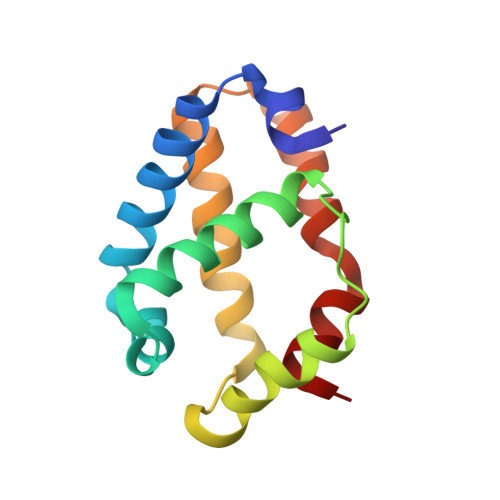Functional and structural characterization of the 2/2 hemoglobin from Synechococcus sp. PCC 7002.
Scott, N.L., Xu, Y., Shen, G., Vuletich, D.A., Falzone, C.J., Li, Z., Ludwig, M., Pond, M.P., Preimesberger, M.R., Bryant, D.A., Lecomte, J.T.(2010) Biochemistry 49: 7000-7011
- PubMed: 20669934
- DOI: https://doi.org/10.1021/bi100463d
- Primary Citation of Related Structures:
2KSC - PubMed Abstract:
Cyanobacterium Synechococcus sp. PCC 7002 contains a single gene (glbN) coding for GlbN, a protein of the 2/2 hemoglobin lineage. The precise function of GlbN is not known, but comparison to similar 2/2 hemoglobins suggests that reversible dioxygen binding is not its main activity. In this report, the results of in vitro and in vivo experiments probing the role of GlbN are presented. Transcription profiling indicated that glbN is not strongly regulated under any of a large number of growth conditions and that the gene is probably constitutively expressed. High levels of nitrate, used as the sole source of nitrogen, and exposure to nitric oxide were tolerated better by the wild-type strain than a glbN null mutant, whereas overproduction of GlbN in the null mutant background restored the wild-type growth. The cellular contents of reactive oxygen/nitrogen species were elevated in the null mutant under all conditions and were highest under NO challenge or in the presence of high nitrate concentrations. GlbN overproduction attenuated these contents significantly under the latter conditions. The analysis of cell extracts revealed that the heme of GlbN was covalently bound to overproduced GlbN apoprotein in cells grown under microoxic conditions. A peroxidase assay showed that purified GlbN does not possess significant hydrogen peroxidase activity. It was concluded that GlbN protects cells from reactive nitrogen species that could be encountered naturally during growth on nitrate or under denitrifying conditions. The solution structure of covalently modified GlbN was determined and used to rationalize some of its chemical properties.
Organizational Affiliation:
Department of Chemistry, The Pennsylvania State University, University Park, Pennsylvania 16802, USA.















